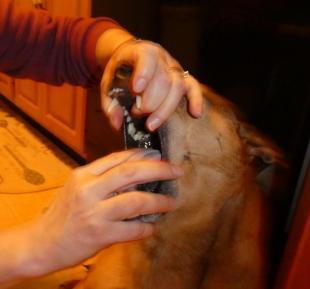Pill Your Pet Without the Drama
- posted: May 31, 2019

Our pets often need to take medications for both preventative purposes such as monthly heartworm products or sometimes on a daily basis for chronic illnesses such epilepsy or hyperthyroidism. But what if your pet is not a good pill taker? Some pets run and hide at the sight of a pill bottle, clamp their mouths shut, or “cheek” the pill and spit it out later. Here are some tips on medicating those difficult pets, and some alternatives to giving pills that we have available at Patton.
Most (though not all) dogs will take pills if hidden in a tasty bit of food. Peanut butter typically works well, but small bits of cheese, lunchmeat, liverwurst or canned dog food can also be used. Pill Pockets made by the Greenies company are semi-soft treats that have a small opening into which a pill can be placed and the treat “smooshed” around the pill to conceal it. Use caution giving meds in food if your pet has food allergies or other dietary restrictions (FYI: Pill Pockets do come in hypoallergenic flavors!).
If giving your dog a pill in a food treat, give a “blank” treat first—in other words, a piece of food or a treat without the medication in it. This prevents the pet from becoming suspicious and is something tasty which gets them excited. Hide the medication in the next treat. Hopefully, your pet is already excited by the first treat and will gobble the second containing the pill without a second thought. Give one final “blank” treat to seal the deal! Make sure to use only enough food to cover the pill. Large portions of extra foods like lunch meat and peanut butter can cause weight gain. Keep treats small!
If you have a picky pooch, one who isn’t eating or who isn’t food motivated, you may have to “pill” your pet. To pill a dog, place your non-dominant hand on top of the head or snout, use your other hand to open the mouth by placing your fingers over the lower incisors and pulling the lower jaw open.Then, quickly push the pill onto the back of the tongue and close the dog’s mouth until he swallows. Alternatively, a “pill shooter” can be used—a plastic device that can be put into the pet’s mouth to “shoot” the pill into the back of the mouth. The same method can be used to pill a cat.
If pilling is just not possible, ask your vet if alternative formulations are available. Patton Veterinary Hospital has liquids, transdermal products that absorb through the skin or even injectable drugs administered at the office that can make medicating pets much easier.
Cats are even better than dogs at refusing to take their medications. Cats can be taught to accept small food treats using the method described above for dogs. You may want to mix up the number of treats and order of where the pill is hidden so cats don’t learn the routine. Keep treats small so cats don’t have to chew so they don’t accidentally bite into the medication. Also, don’t be alarmed if your kitty starts foaming at the mouth after she receives a medication: It is not an allergic reaction. The pill or liquid likely tastes very bitter causing your cat to salivate. Once the bad taste goes away, it should stop.
Hopefully, these tips make giving your dog or cat a pill a little easier, whether it’s two weeks of antibiotics or two years of daily medications for heart disease. And, if you’re really struggling to medicate your pet, talk to our staff. Compliance is key to keeping your pet healthy. We have lots of tips and tricks for helping your pet take his or her drugs without the drama!
This blog brought to you by the Patton Veterinary Hospital serving Red Lion, York and the surrounding communities.
Location
Patton Veterinary Hospital
425 E Broadway
Red Lion, PA 17356
